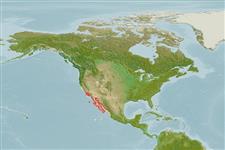分類 / Names
共通名の | 類義語 | Catalog of Fishes(部類, 種) | ITIS | CoL | WoRMS | Cloffa
Environment: milieu / climate zone / depth range / distribution range
生態学
海; 汽水性の 底生の; 深さの範囲 1 - 91 m (Ref. 48844), usually 1 - 13 m (Ref. 48844). Tropical; 38°N - 18°N, 123°W - 106°W (Ref. 114953)
Eastern Pacific: endemic to the eastern Pacific from San Francisco, USA to the Gulf of California, and possibly to Mazatlan, Mexico (Ref. 48844).
Length at first maturity / サイズ / 重さ / 年齢
Maturity: Lm ?, range 57 - ? cm
Max length : 119 cm TL オス/雌雄の選別がない; (Ref. 48844); 170.0 cm TL (female); 最大公表体重: 9.8 kg (Ref. 40637); 最大公表体重: 9.8 kg; 最大記録サイズ: 16 年 (Ref. 48844)
Broad disc is greater in length than width; a relatively smooth dorsal surface except for a single row of thorns around the eyes and extending along the back and tail; a long, pointed snout with a rounded tip; small, rounded, pebble-like teeth; a first dorsal fin that originates closer to the pelvic fin base than to the caudal fin origin; a thick tail and a moderately large caudal fin without a distinct lower lobe. Tooth count: 102-112/98-117. Spiral valve count: 8-10.
Found on sand or mud bottoms of bays, seagrass beds, estuaries, and near rocky reefs. Nomadic and gregarious. Found singly or in aggregations (Ref. 12951). Burrows in sand during the day, feeds on crabs, worms, clams and small fishes at night (Ref. 12951). Ovoviviparous, with 6 to 28 pups in a litter (Ref. 48844). Females mature by 7 years at 87-99 cm TL; males reaches 91-110 cm TL; birth size at 20-24 cm TL (Ref. 114953).
Etymology: The genus comes from the Greek word rhine, meaning shark, and the Latin word batis, meaning ray, in reference to its body form being intermediate between that of a shark and a ray. The species name comes Latin, meaning produced, in reference to its pointed snout (Ref. 48844).
Life cycle and mating behavior
成熟 | 繁殖 | 放精 | 卵 | 生産力 | 幼生
Exhibit ovoviparity (aplacental viviparity), with embryos feeding initially on yolk, then receiving additional nourishment from the mother by indirect absorption of uterine fluid enriched with mucus, fat or protein through specialised structures (Ref. 50449).
Adults of both sexes congregate during the breeding season in shallow bays and estuaries and likewise leave when the pupping season is over after mating (Ref. 48844). Gestation lasts for about 12 months (Ref. 48844).
Eschmeyer, W.N., E.S. Herald and H. Hammann, 1983. A field guide to Pacific coast fishes of North America. Boston (MA, USA): Houghton Mifflin Company. xii+336 p. (Ref. 2850)
Human uses
水産業: 商業; ゲームフィッシュ: はい
より多くの情報
参考文献水産養殖水産養殖の紹介緊張遺伝子のElectrophoreses遺伝病気行列NutrientsMass conversion
協力者画像Stamps, Coins Misc.音シガテラ(食中毒の名前)速度泳ぐ 型式カマOtoliths脳視覚
用具
特記事項
XMLをダウンロードして下さい
インターネットの情報源
Estimates based on models
Preferred temperature (Ref.
123201): 15.3 - 25.9, mean 22.4 °C (based on 149 cells).
Phylogenetic diversity index (Ref.
82804): PD
50 = 0.5039 [Uniqueness, from 0.5 = low to 2.0 = high].
Bayesian length-weight: a=0.00209 (0.00137 - 0.00319), b=3.10 (2.98 - 3.22), in cm total length, based on LWR estimates for this species & Genus-body shape (Ref.
93245).
栄養段階 (Ref.
69278): 3.6 ±0.3 se; based on diet studies.
Generation time: 11.0 ( na - na) years. Estimated as median ln(3)/K based on 2
growth studies.
回復力 (Ref.
120179): 低い, 4.5年~14年の倍増期間の最小個体群 (tm=7; tmax=11; K=0.1; Fec = 6).
Fishing Vulnerability (Ref.
59153): High vulnerability (65 of 100).
Nutrients (Ref.
124155): Calcium = 32.6 [8.1, 140.3] mg/100g; Iron = 0.666 [0.163, 1.807] mg/100g; Protein = 18.8 [16.7, 20.7] %; Omega3 = 0.146 [0.065, 0.333] g/100g; Selenium = 50.9 [14.7, 138.9] μg/100g; VitaminA = 12.1 [5.5, 26.8] μg/100g; Zinc = 1.03 [0.51, 1.86] mg/100g (wet weight);
